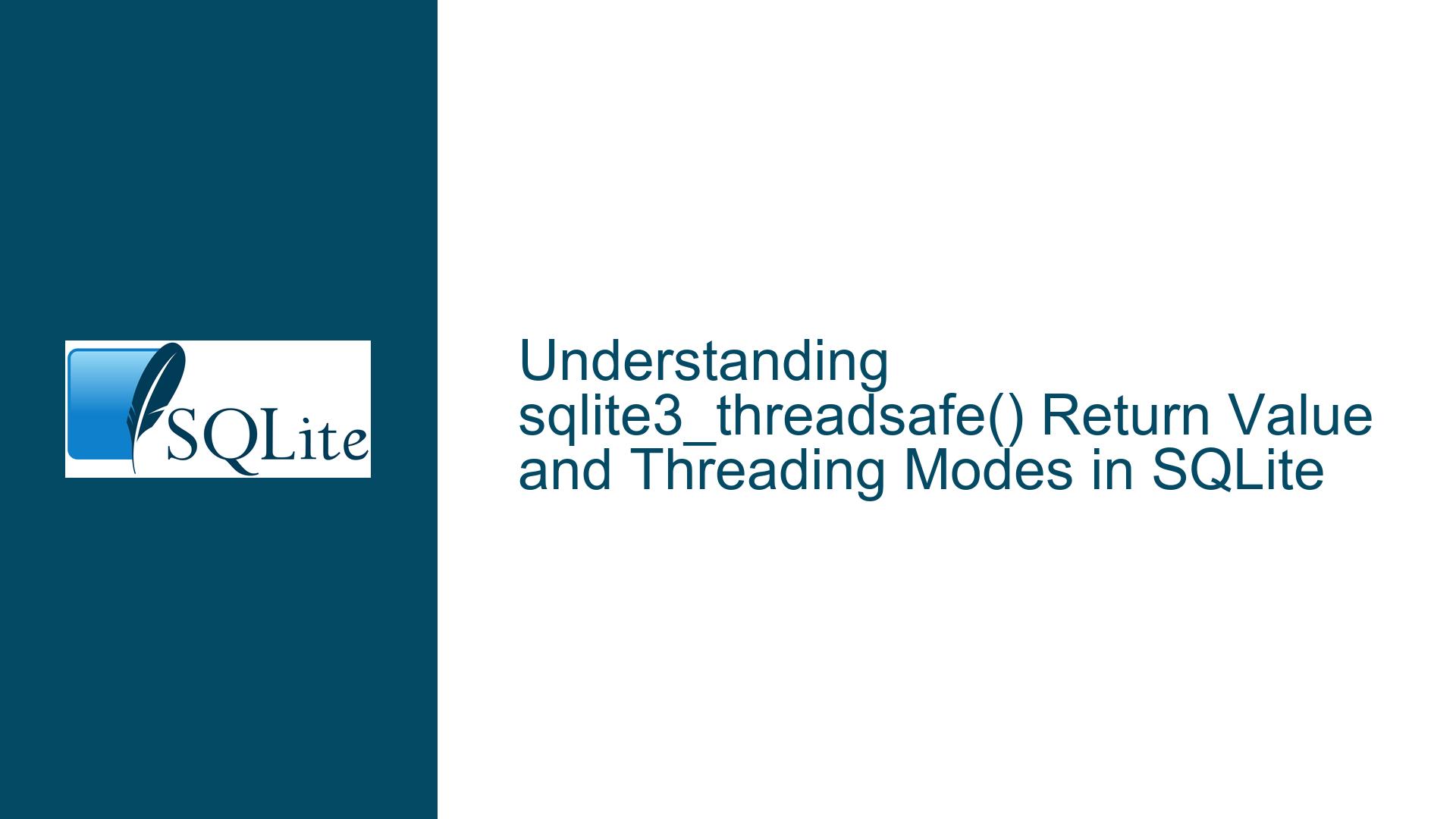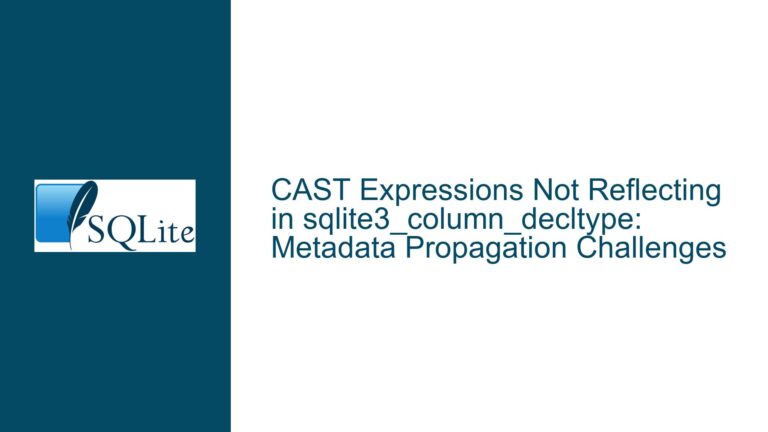sqlite3_threadsafe() Return Value and Threading Modes in SQLite
Issue Overview: sqlite3_threadsafe() Return Value Misinterpretation and Threading Mode Confusion
The core issue revolves around the behavior and interpretation of the sqlite3_threadsafe() function in SQLite, particularly in relation to its return value and how it reflects the threading mode of the SQLite library. The function sqlite3_threadsafe() is designed to return a value that indicates whether the SQLite library was compiled with thread safety enabled. However, there is significant confusion regarding what this return value actually represents, especially in the context of runtime threading mode changes and the distinction between multi-thread and serialized modes.
The confusion stems from the fact that sqlite3_threadsafe() returns a compile-time constant, SQLITE_THREADSAFE, which is determined during the compilation of the SQLite library. This constant reflects the threading mode that was selected at compile time, but it does not provide information about the current runtime threading mode of the SQLite instance. The runtime threading mode can be altered using pragmas or other runtime configurations, and these changes are not reflected in the return value of sqlite3_threadsafe().
This discrepancy between compile-time and runtime threading modes has led to misunderstandings, particularly in scenarios where developers expect sqlite3_threadsafe() to provide real-time information about the current threading mode of the SQLite library. The documentation initially suggested that sqlite3_threadsafe() is unable to distinguish between multi-thread and serialized modes, which further added to the confusion. However, this statement was later clarified to indicate that the function’s return value is solely based on the compile-time setting and does not reflect runtime changes.
Possible Causes: Misalignment Between Compile-Time and Runtime Threading Modes
The primary cause of the confusion lies in the misalignment between the compile-time threading mode setting and the runtime threading mode configuration in SQLite. When SQLite is compiled, the SQLITE_THREADSAFE macro is used to define the threading mode, which can be set to one of the following values:
0: Threading mode is disabled (single-thread mode).1: Multi-thread mode is enabled.2: Serialized mode is enabled (fully thread-safe).
The sqlite3_threadsafe() function simply returns the value of SQLITE_THREADSAFE, which is determined at compile time. However, the actual threading mode used by SQLite at runtime can be different from the compile-time setting. This is because SQLite allows the threading mode to be changed at runtime using the sqlite3_config() function or via pragmas such as PRAGMA threading_mode.
For example, even if SQLite is compiled with SQLITE_THREADSAFE=2 (serialized mode), the runtime threading mode can be changed to multi-thread mode using sqlite3_config(SQLITE_CONFIG_MULTITHREAD). In such cases, the sqlite3_threadsafe() function will still return 2, even though the actual runtime mode is multi-thread. This misalignment between compile-time and runtime settings can lead to incorrect assumptions about the threading behavior of the SQLite library.
Another contributing factor to the confusion is the documentation’s initial wording, which suggested that sqlite3_threadsafe() is unable to distinguish between multi-thread and serialized modes. This statement was interpreted by some developers as implying that the function’s return value is ambiguous or unreliable. However, the function’s behavior is actually straightforward: it returns the compile-time threading mode setting, and it does not attempt to reflect runtime changes.
Troubleshooting Steps, Solutions & Fixes: Clarifying sqlite3_threadsafe() Behavior and Ensuring Correct Threading Mode Usage
To address the confusion surrounding sqlite3_threadsafe() and ensure that developers correctly understand and use the threading modes in SQLite, the following steps and solutions are recommended:
Clarify the Documentation: The documentation should clearly state that
sqlite3_threadsafe()returns the compile-time threading mode setting and does not reflect runtime changes. The revised documentation should also explain the distinction between compile-time and runtime threading modes, and provide examples of how the threading mode can be changed at runtime.For example, the documentation could be updated to include the following clarification:
- "The
sqlite3_threadsafe()function returns the compile-time threading mode setting, as defined by theSQLITE_THREADSAFEmacro. This value does not reflect any runtime changes to the threading mode, which can be made usingsqlite3_config()or pragmas such asPRAGMA threading_mode."
- "The
Use Runtime Threading Mode Checks: Developers should be aware that
sqlite3_threadsafe()does not provide real-time information about the current threading mode. Instead, they should use other methods to determine the runtime threading mode, such as querying thePRAGMA threading_modesetting or using thesqlite3_config()function to retrieve the current threading mode.For example, the following code snippet demonstrates how to check the runtime threading mode using
PRAGMA threading_mode:sqlite3 *db; sqlite3_open(":memory:", &db); sqlite3_exec(db, "PRAGMA threading_mode;", callback, 0, 0);In this example, the
callbackfunction would receive the current threading mode as a result of thePRAGMA threading_modequery.Ensure Consistent Threading Mode Usage: Developers should ensure that the threading mode used at runtime is consistent with the intended behavior of their application. If the application requires a specific threading mode (e.g., serialized mode for full thread safety), the runtime threading mode should be explicitly set using
sqlite3_config()orPRAGMA threading_mode.For example, the following code snippet demonstrates how to set the runtime threading mode to serialized mode:
sqlite3_config(SQLITE_CONFIG_SERIALIZED);This ensures that the SQLite library operates in serialized mode, regardless of the compile-time threading mode setting.
Avoid Relying Solely on sqlite3_threadsafe(): Developers should avoid relying solely on the return value of
sqlite3_threadsafe()to determine the threading behavior of the SQLite library. Instead, they should consider both the compile-time and runtime threading mode settings, and ensure that the runtime mode is configured appropriately for their application’s needs.For example, if the application requires multi-thread mode, the developer should explicitly set the runtime mode to multi-thread using
sqlite3_config(SQLITE_CONFIG_MULTITHREAD)orPRAGMA threading_mode=multi-thread.Test and Validate Threading Behavior: Developers should thoroughly test and validate the threading behavior of their application, especially in scenarios where multiple threads interact with the SQLite library. This includes testing with different compile-time and runtime threading mode settings to ensure that the application behaves as expected in all scenarios.
For example, developers can create test cases that simulate multi-threaded access to the SQLite database and verify that the application handles concurrent access correctly, regardless of the threading mode settings.
By following these steps and solutions, developers can avoid the confusion surrounding sqlite3_threadsafe() and ensure that their applications correctly use the threading modes in SQLite. The key takeaway is that sqlite3_threadsafe() provides information about the compile-time threading mode setting, but it does not reflect runtime changes. Developers should use additional methods to determine and configure the runtime threading mode, and ensure that their applications are tested and validated for the intended threading behavior.






